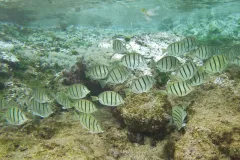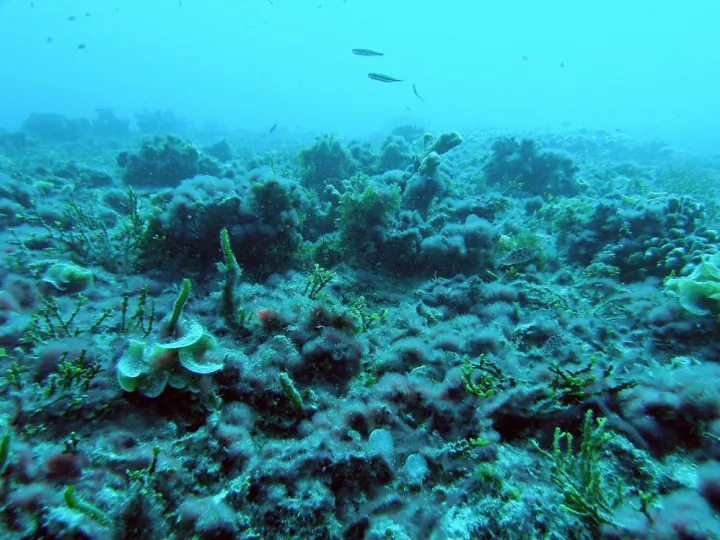Helpful Herbivores

When snorkeling in the Kahekili Herbivore Fisheries Management Area (KHFMA) in West Maui, I keep an eye out for certain kinds of fish. Not the brightest or the biggest, but those herbivores such as uhu (parrotfish), lau'ipala (yellow tang), or na'ena'e (orangeband surgeonfish) that mow algae. These fish can tell me whether a unique experiment in coral reef management that has the potential to restore ecological resilience—the ability for an ecosystem to rebound after a disturbance—is working. Inside the KHFMA, fishing for herbivorous fishes and urchins is banned, so the species I’m hoping to see should be easier to find than they were before we started. But what does protecting herbivores have to do with reef resilience?
We’re learning to estimate how resilient an ecosystem is by measuring certain properties after environmental disturbances. For coral reefs, one of these key properties is how the reef retains and regrows coral. Corals are living animals that build the reef, providing habitat for an extraordinary diversity of coral reef species. Healthy corals also protect coastlines from storms, promote productive fisheries, build surf breaks, and support the tourism industry that is the basis of many local economies. On reefs around the world, the resilience of coral reefs is declining due to a suite of chronic local disturbances, like overfishing and coastal water pollution, and larger, global disturbances like warmer water temperatures and acidification. The net result is that, after being hit by a large disruption such as damage from a large storm, corals don’t recover and the reef-builders give way to the growth of fleshy macroalgae, which provide few of the benefits of a healthy reef.
In recent years, West Maui has experienced periodic blooms of seaweed, raising concerns about the future health of its corals. However, there is a way to clean up the seaweed: by making sure that the herbivorous fish that eat it are plentiful. By protecting herbivores from intense fishing pressure, Hawai’i’s Department of Land and Natural Resources, Division of Aquatic Resources is hoping to build reef resilience with abundant and diverse herbivores, helping to keep the reef clear of macroalgae and making a better environment for corals.
Established in 2009, the KHFMA is starting to show results, with measurable increases in the size and abundance of some herbivores. However, seaweed blooms are still a problem, indicating that there is more work to be done. Resource managers and stakeholders are now shifting their focus to reducing land-based pollution, especially from wastewater laden with excess nutrients, which stimulates the growth of algae.
Just across the street from the KHFMA is a Maui County wastewater treatment plant, which cleans and removes many—but not all—of the nutrients from the wastewater from the hotels and other residences and business in the region. After treatment, the wastewater is driven underground where it eventually makes its way to nearby reefs, bringing nutrients that can fuel algal growth. Fortunately, there’s growing interest in a solution: hotels, golf courses, and others can use fully treated wastewater to grow their landscape plants, which can also use the remaining nutrients. This solution isn’t only good for the reef; it also means cheaper water bills for hotels and golf courses and reduced demand on the drinking water supply. The net result of more herbivores and less land-based pollution is a reef where corals are better able to thrive, even when hit by the disturbances we can’t manage at the local scale, like high temperatures, acidification or big storms.
As I swim back to the beach at the end of my trip, I spot of school of adult na’ena’e in the shallows, fish that might otherwise have been taken long ago by fishermen. The school swims a short way and then dives to the bottom where each fish takes a few bites of the low-growing algae on the rocks between corals. Over and over again they dive and graze, helping to keep the reef healthy and resilient.


